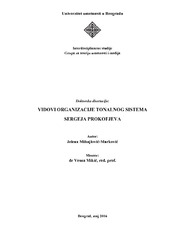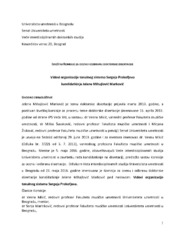| dc.contributor.advisor | Mikić, Vesna | |
| dc.contributor.other | Marinković, Sonja | |
| dc.contributor.other | Sabo, Anica | |
| dc.contributor.other | Popović Mladjenović, Tijana | |
| dc.contributor.other | Tomašević, Katarina | |
| dc.creator | Mihajlović Marković, Jelena | |
| dc.date.accessioned | 2016-05-24T13:40:00Z | |
| dc.date.available | 2016-05-24T13:40:00Z | |
| dc.date.issued | 2016-07-18 | |
| dc.date.submitted | 2016-05-24 | |
| dc.identifier.uri | http://eteze.arts.bg.ac.rs/handle/123456789/150 | |
| dc.description.abstract | Predmet proučavanja ove disertacije jeste tonalna struktura u harmonskom sistemu Sergeja Prokofjeva, koja se iskazuje kao jedan od ključnih označitelja njegovog upečatljivog i veoma prepoznatljivog muzičkog govora. Osobenost zvučnog prostora u muzici jednog od najznačajnijih kompozitora 20. veka, ogleda se u specifičnoj sprezi i prelamanju dijatonike i hromatike, modalnog i tonalnog, ostvarenim na način kojim se sveobuhvatnost tog prostora iskazuje unutar ne samo jasne centralizacije tonaliteta, već i tonalnog roda. U brojnim dosadašnjim teorijskim postavkama ruskih i anglosaksonskih teoretičara, uočava se terminološka neusaglašenost u definisanju tonalnog sistema ovog autora; većina se, ipak, slaže u tome da je njegova muzika tonalna. Polazeći od te pretpostavke, jedan od ciljeva rada jeste da najpre otkrije i definiše, a potom i tipološki sistematizuje sve postupke i procedure na osnovu kojih bi se formirao teorijski okvir za tumačenje specifičnog tonalnog jezika Prokofjeva, kao i prilog dubljem razumevanju stvaralačke poetike kompozitora. U tom cilju detaljno su proučeni: unutar-tonalni i međutonalni odnosi, politonalni i među-tonalni prostori, presek horizontalnog i vertikalnog uzajamnog dejstva, profil akordike unutar odnosa dijatonika-hromatika, kao i načini promene tonaliteta.
Navedene oblasti proučene su na osnovu detaljne analize devet sonata za klavir koje, nastale u
vremenskom okviru od skoro četrdeset godina (1909–1947), spajaju liniju različitih stvaralačkih faza
kompozitora, te predstavlju mogući obrazac za sagledavanje tretmana forme, tematizma, osobenog spoja linearnosti i vertikalnog nadslojavanja, a naročito harmonskog sistema i strukture tonalnosti.
Jedan od, takođe, ključnih označitelja harmonskog jezika Prokofjeva jeste pozicija dijatonike i njeno
dejstvo unutar hromatizovanog tonalnog prostora. Iz tog razloga bilo je neophodno poći od proučavanja odnosa dijatonika – hromatika, kao ključnog polja unutar koga smo najpre ispitali analitičke interpretacije pojedinačnih elemenata dijatonike, a potom sagledali i ukrštanje međusobnog dejstva dijatonike sa hromatikom, načina na koje se takva dejstva ispoljavaju, kao i u kom stepenu zastupljenosti pojedinačnih elemenata se oni manifestuju. Dijatonika kao jedna od ključnih tačaka u ostvarivanju tonalne stabilnosti unutar složenijih hromatizacijskih slojeva, iskazuje se, pored ostalih, i na način koji dijatonizira upravo isti hromatski tonski prostor. Sa druge strane, hromatika se iskazuje kako u linearnom-melodijskom, tako još više u vertikalnom smislu, gde su hromatska zasićenja proizvod bilo naslojavanja različitih akordskih formacija, često bikordalnih bilo onih, koji u sudaru sa (ponovo) dijatonskim akordima tvore specifične zvučne sklopove. U tom smislu osim, za Prokofjeva tipičnih – Lidijskog, Frigijskog i Polarnog akorda, posebno su izdvojene složene strukture sa dvorodnim i disalterovanim tonovima, a predložena je i nova tipologija vertikalnih formacija u koju su svrstani vođični, prijanjajući, klizajući akordi i hromatski dvojnik.
Težište rada čini istraživanje strukture tonalnog sistema, te smo u ovoj disertaciji ponudili kriterijume za hipotezu nove tipologije vidova ispoljavanja složenosti tog sistema. Specifičan spoj dijatonike sa
hromatikom, tonalnih i modalnih obeležja, objašnjen je kao činilac koji uslovljava ekstenziju gravitacionog polja zajedničkog tonskog prostora, čime se, u sadejstvu sa navedenim pod-sistemima, formira suštinski novi oblik tonalne višeslojnosti, koji se manifestuje kroz tri osnova upečatljiva modaliteta. To su: fuzija više vrsta tonal-modaliteta u jednom (zajedničkom) centru; asocijativno-policentrična tonalnost i međutonalni prostor – međutonalnost. Jedna od posebno detaljno proučenih oblasti je i fenomen klizanja, čiji značaj se ogleda u uticaju na hromatizacijskom proširenju tonalnog centra. Ovaj fenomen, idiosinkratičan za Prokofjeva, iskazuje se u dva vida, a sistematizovan je i definisan kao 1) iskliznuće i 2) hromatsko akordsko klizanje. Iskliznuće se manifestuje u dva vida: sa tonalnim izmeštanjem, i u vidu unutartonalnog ili melodijskog
iskliznuća (koje dovodi do simulacije bitonalnosti). Treća značajna proučena oblast jeste način promene tonaliteta, gde se, takođe, kao idiosinkratične izdvajaju tri vrste. Ove modulacije nisu dosad bile prepoznate unutar interpretacijskog okvira tonalne harmonije, te je predložena njihova tipologija. Na osnovu detaljno sagledanih i precizno proučenih harmonskih procedura u odabranom analitičkom korpusu, može se zaključiti da se međutonalno prelamanje i presek sa asocijativnim tonalnim platoima, kao i sapostojanje ovih tonalnih prostora u fuziji sa elementima više pod-sistema, iskazuju kao najznačajnije determinante u pretpostavci definisanja sveobuhvatnog tonalnog polja unutar predloženih (novih) vidova organizovanja tonalnog sistema Sergeja Prokofjeva. | sr |
| dc.description.abstract | The subject of this dissertation is the exceptional tonal structure in the harmonic system of Sergei
Prokofiev, one of the most prominent composers of the 20th century. His tonal system is one of the key points in determining his outstanding and notably recognisable music language. The exquisite sound sphere of his music is reflected in specific interactions and refractions of diatonic and chromatic spheres, as well as of modal and tonal elements; these are accomplished in such a manner that direct the allencompassing sound space not only to one undeniable key center but also, to a clear key mode (minor or major).
The numerous studies by Russian and Anglo-Saxon theorist which deal with defining Prokofiev’s tonal system show significant terminological divergence; nevertheless, most of them do not deny that his music is tonal. One of the main fields of this research is identifying and defining all the processes and procedures in order to form a systematic typology, the basis for a theoretical interpretation of the specific tonal design as well as of the very music poetics of Sergei Prokofiev.
The dissertation brings a thorough examination of relations both in and out of tonality i.e. those within one center and between different centers; furthermore, the research includes polytonal and inter-tonal spaces, interaction mutual effects between the linear chromatic and vertical diatonic spheres, chord profiles within diatonic-chromatic relations, and modulation techniques. Examinations of these fields and procedures were conducted through detailed analyses of nine Piano sonatas which, being composed during almost forty years (1909–1947), connect the diverse creative composer’s phases. They are observed as a possible pattern for perceiving the treatment of form, thematic shaping, the specific junction of linear and vertical layers, and especially for the harmonic system and tonal structure.
One of the key elements to elicit the harmonic speech of Prokofiev is also the manifestation of diatonics within the chromaticized tonal space. Thus, the diatonic-chromatic relation was the initial point of the research within which the interpretations of separate diatonic elements were firstly analyzed, followed by examining the manifestation of their interaction and mutual influence with chromatics, with regard to grading the presence of each of these elements. Diatonics, as the crucial point in preserving the tonal stability within complex chromatized layers, is manifested in the specific way which enables the same chromatic tone space to sound in a diatonic manner. On the other hand, chromatism is manifested both in linear-melodic and even more in vertical aspects, where chromatic complexity derives from the superimposition of various chord formations, as in bi-chord stuctures, or in junction with (again) diatonic chords. Aside from the Lydian, Phrygian and Polar chords, typical for Prokofiev, other complex structures with disaltered tones were especially emphasized; a new chord typology was also proposed introducing leading-chord structures, sliding chords, leaning-chords and chromatic twins.
The main focus of this work is the research of the structure of the tonal system, and the criterion for the hypothesis of a new typology of its complex manifestations was subsequently proposed.
The specific junctions of diatonic and chromatic sub-systems and tonal and modal elements are pointed out as crucial elements in building-up the extension of the gravitation sphere of one common tone space, in which new forms of multi-layer tonality are demonstrated. There are three basic modalities which manifest these junctions. 1) Fusion of several scale types with the same tonic (major, minor, modes), 2) Associative level, or associative-polycentric tonality, meaning refraction of two or more different keys and, 3) Inter-tonal space (intertonality), meaning fusion of several different tonal centers into one layer. The phenomenon of chromatic slippages is also emphasized, as its influence on the chromatic extension of the tonal center is of notable significance. This phenomenon, idiosyncratic for Prokofiev, is manifested in two ways which were systematized and defined in this dissertation as: 1) slippage and 2) chromatic chord sliding. The slippage is realized in two basic ways – the first resulting with a tonal shift, and the second within one key as an inner-tonal or melodic slippage (leading to the simulation of bitonality).
Finally, the third significant field of research was devoted to tonal shifts, within which are three types
recognized as idiosyncratic, and a new typology is proposed since they have not been so far systematized within the analytical frame of tonal harmony. The thorough and precise interpretations of complex harmonic procedures in the analytical samples confirm that the inter-tonal refractions, their intersection with associative tonal plans, as well as with the fusion of various sub-system elements, represent the most outstanding determinants in defining the all-encompassing tonal field within the proposed new ways of tonal organization in the music of Sergei Prokofiev. | sr |
| dc.language.iso | srp | sr |
| dc.publisher | Универзитет уметности у Београду, Интердисциплинарне студије Универзитета уметности | sr |
| dc.source | Интердисциплинарне студије Универзитета уметности | sr |
| dc.subject | Prokofjev | sr |
| dc.subject | Prokofiev | sr |
| dc.subject | struktura tonaliteta/tonalnosti | sr |
| dc.subject | fuzija modalnosti i tonaliteta | sr |
| dc.subject | međutonalnost | sr |
| dc.subject | hromatsko akordsko klizanje | sr |
| dc.subject | vođična modulacija | sr |
| dc.subject | modulacija pomoću akordskog klizanja | sr |
| dc.subject | modulacija pomoću intonativnog mosta | sr |
| dc.subject | vođični akord | sr |
| dc.subject | prijanjajući akord | sr |
| dc.subject | hromatski dvojnik | sr |
| dc.subject | simulacija bitonalnosti | sr |
| dc.subject | asocijativnopolicentrična tonalnost | sr |
| dc.subject | tonal structure | sr |
| dc.subject | fusion of modes and tonality | sr |
| dc.subject | associative-polycentric tonality | sr |
| dc.subject | intertonality | sr |
| dc.subject | chromatic chord sliding | sr |
| dc.subject | leading-tone modulation | sr |
| dc.subject | sliding-chord modulation | sr |
| dc.subject | intonation-transition link | sr |
| dc.subject | leading-chord | sr |
| dc.subject | leaning chord | sr |
| dc.subject | chromatic twin | sr |
| dc.subject | simulation of bitonality | sr |
| dc.title | Vidovi organizacije tonalnog sistema Sergeja Prokofjeva | sr |
| dc.type | doctoralThesis | en |
| dcterms.abstract | Микић, Весна; Томашевић, Катарина; Сабо, Aница; Маринковић, Соња; Поповић Младјеновић, Тијана; Михајловић Марковић, Јелена; Видови организације тоналног система Сергеја Прокофјева; Видови организације тоналног система Сергеја Прокофјева; | |


